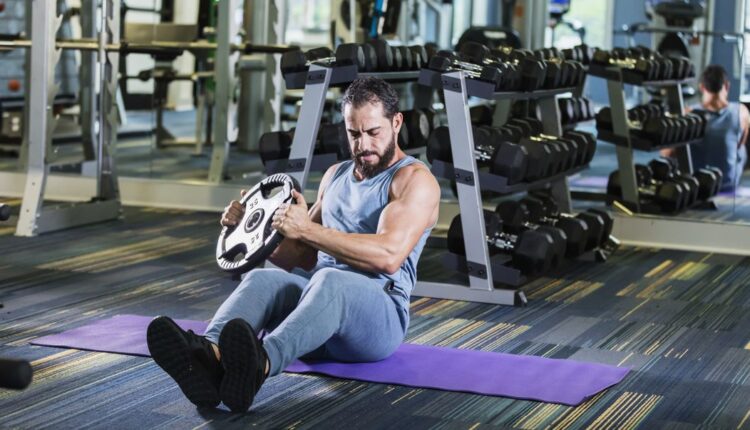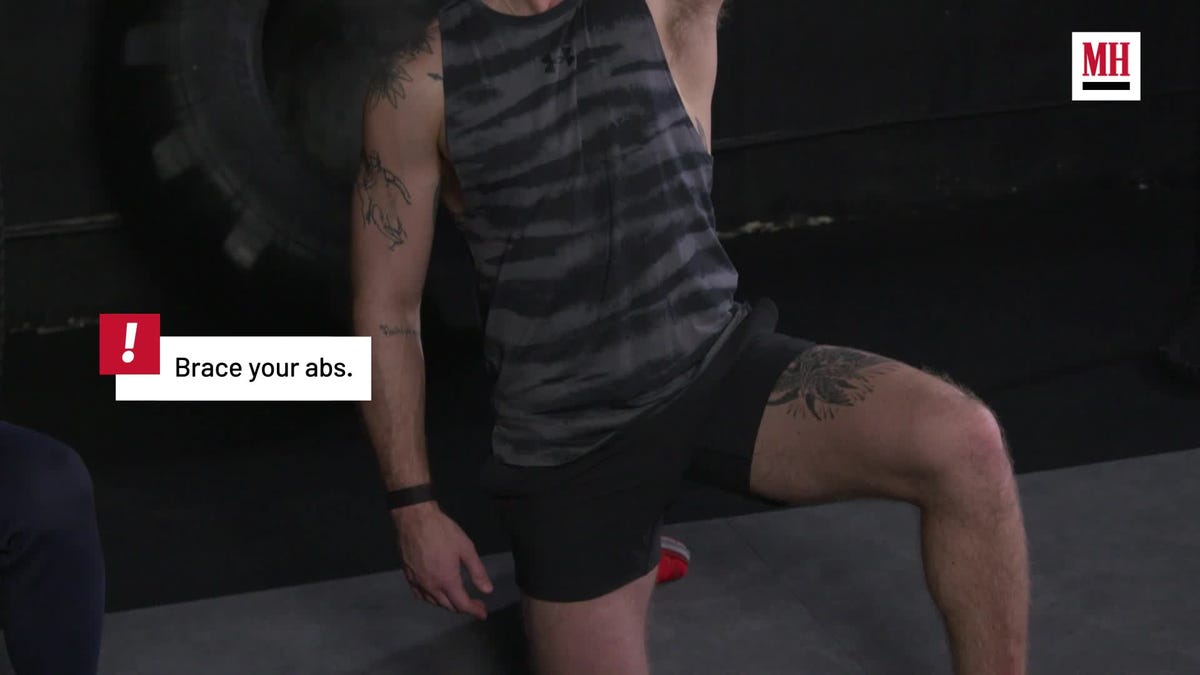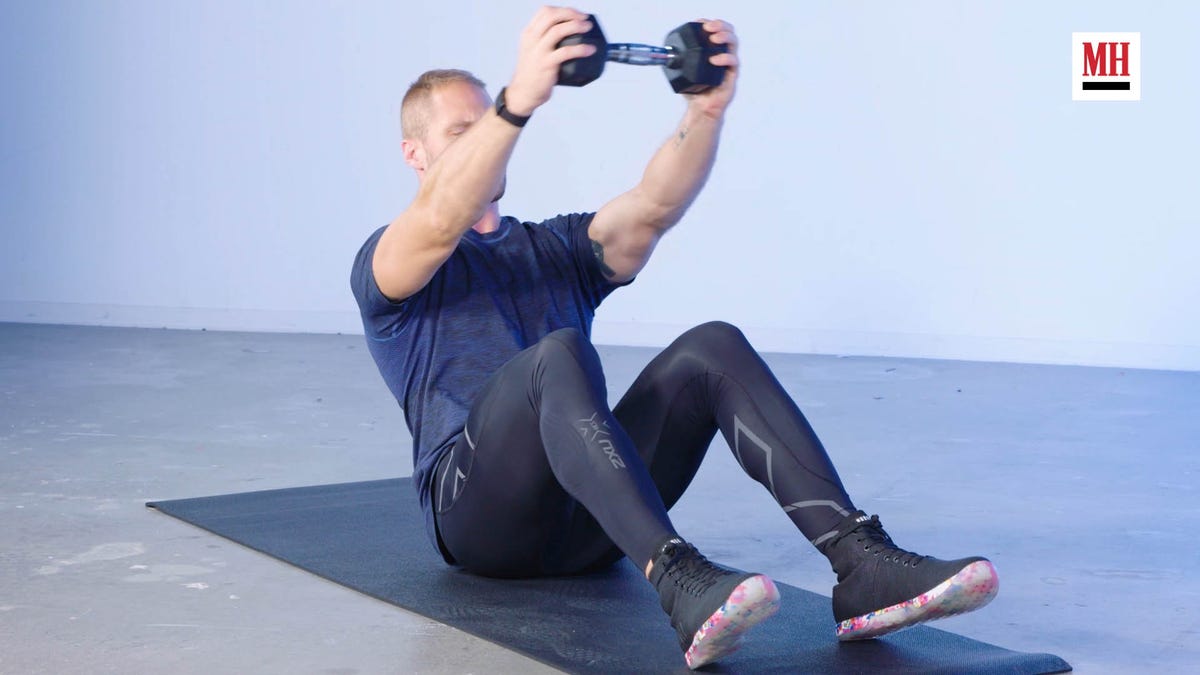YOUR CORE TRAINING routine needs to evolve beyond bodyweight. Whether your goal is to train for aesthetics or performance (hopefully, you’ll be concerned about both), you’ll only get so far by racking up rep after rep of unloaded movements and minutes of static holds when you focus on your core muscle.
If you want to build the visually impressive six-pack you’re yearning for while also continuing to improve functionality and strength, there’s one obvious way forward: add some weight to your ab workout.
“I think a lot of people out there approach abs the incorrect way,” MH Advisory Board member Don Saladino said when he and MH fitness director Ebenezer Samuel, C.S.C.S. outlined their picks for must-do abs exercises. “They’re going to sit there and pump out a thousand crunches, they’re just trying to focus on that burn. I’ve always tried to approach ab training in the way I’d train every other muscle group.”
There’s a good reason you’ll be better served approaching your core training the same way you train your chest, arms, or legs: The same principle of progressive overload applies. As Saladino notes, the way lots of people train their abs only depends on ramping up the volume of reps to increase the muscle-building stimulus.
You might not be able to move big weights like you would with other muscle groups, but adding load is another important way that you can progressively overload your core muscles. That helps to kick-start hypertrophy, the process of building muscle, and after enough focused work, you’ll likely begin to see (and importantly, feel) results.
Benefits of Weighted Abs Exercises
- Less reliance on volume for training stimulus
- Helps strengthen core muscles
- Helps increase strength for other lifts
- Promotes better posture
Adding weighted ab exercises to your core training has more benefits than just cutting down your your rep count.
You’ll build strength, and in creating a stronger core, you’ll see a trickle-down effect to your other muscles and exercises. Your core is important for bracing to protect your spine, which helps to reinforce good posture and is key for big time lifts. “Don’t be afraid to load your abs, period,” Samuel said in the above clip. “Your abs need to be strong so you can squat better, deadlift better—you can hit all your exercises better.”
Take this advice to heart and add these weighted abs exercises to your core training regimen. Start with light weights—but don’t be scared to progress over time as you get stronger.
The Best Weighted Abs Exercises
Hollow holds teach us how to brace. The better we improve this movement (or lack thereof) with our body weight and a slight load, the benefits—a more sturdy and resilient foundation—will show themselves in other movements. Form is essential, so pay attention to form cues.
How to Do It:
- Lie down on the ground, and drive your lower back into the floor. Hold a light weight plate or dumbbell in both hands.
- Lift your legs off the floor just a few inches. At the same time, extend your arms holding the weight behind your head with your shoulders remaining off the floor.
- Squeeze your abs and glutes to create full-body tension. Your lower back should remain planted on the floor. Hold this position.
- Start with three sets of 40-second holds with 20 seconds rest in between.
You’ll add an additional element to this core movement, hitting your lats and challenging your anti-rotational strength. To maximize this exercise, however, be sure to avoid working from a strict tabletop position. Instead of a totally flat back, focus on creating a longer shoulder-to-toe anti-rotational challenge by squeezing abs and tightening your glutes throughout the working period.
How to Do It:
- Place your forearms on a flat bench about shoulder-width apart.
- Grab a dumbbell with one hand.
- As you remain in the plank position, focus on keeping glutes and core tight, especially as you fight to maintain steadiness and tension on the dumbbell side.
- Row until your arm is parallel with your torso. Hold for a moment (this will create an anti-rotational challenge).
- Lower, then repeat.
- Do three sets of 10 to 12 reps with each arm.
The beauty of planks is that there are endless ways to up the intensity. By adding a sled and battle rope pull, you’re raising the core-crushing ante. You can also get a similar challenge by pulling a resistance band or cable, instead of a loaded sled.
How to Do It:
- Start in a forearm plank position, with the rope between both arms. Make sure to be as far from the sled as possible.
- While remaining in plank position, reach with one hand to grab the rope.
- Pull the sled toward you, making sure to keep the arm you’re pulling with remains tight to your body (avoid flaring your elbow out), while at the same time keeping your torso facing the ground.
- Continue pulling until the sled is as close to you as possible.
- Reposition the rope, then repeat with the other arm.
- Do 3 sets with each arm.
This may be the best exercise you may not have already been incorporating in your core workouts. You’ll also get the benefit of improving hip mobility and shoulder stability.
How to Do It:
- Start by setting up in a half-kneeling stance. Your legs should be positioned wider than you normally would for other moves in order to give your hips a bit more room and also allow for more space to move the kettlebell.
- Raise the kettlebell to your shoulder before pressing it overhead. Try not to arch your back, instead, work on keeping your ribcage nice and tight.
- Once overhead, make sure to keep your eyes focused on the kettlebell throughout the movement. Try to turn the pit of your elbow behind you, creating as much external rotation as possible at your shoulder joint.
- Slightly push your glutes back; as you’re doing this, your chest will begin rotating to that side. Squeeze your shoulder blades tight and lower your opposite elbow to the ground.
- Return top start position.
- Perform three sets of six to eight reps on each side. Make sure to try and take two to three seconds to get through each rep.
Lifting heavy objects will always be a fun challenge. Picking up heavy things and walking with them can be downright brutal. When done right, loaded carried becomes a full-body workout, hitting your core, forearms, shoulders, as well as your lower body, making it both a strength and conditioning workout that is one of the most functional exercises in the gym.
How to Do It:
- Set up by grabbing a dumbbell (or kettlebell) and holding one in each hand.
- Squeeze your shoulders, abs, and glutes to establish full-body tension.
- Keep your chin down, looking just ahead to you (to keep your spine in alignment), and rib cage flat.
- Maintaining a tight grip in each hand, begin taking short strides (this will give you a stronger support base).
- Start by walking for 20 seconds at a time, then increase time/distance as needed.
The name may be a mouthful to remember, but this innovative core movement hits your abs, lower back, and obliques.
How to Do It:
- Lie on a decline bench, light weights held in your hands directly above your shoulders, torso parallel to the ground.
- Keeping your hips and shoulders square to the ceiling, extend one arm directly over head and the other arm out to the side. Hold for 3 seconds. Keep your abs tight and do not arch your back.
- Return your arms to directly over your shoulders, keeping your abs tight.
- Repeat on the other side.
- Repeat this pattern for 60 seconds. Then rest 45-60 seconds. Do 3 sets.
You’ll feel like a superhero after this exercise. This move forces your entire core to get to work once you extend your arm, challenging your balance.
How to Do It:
- Start off in a forearm plank position. Using a light resistance band attached to an anchor, hold one end of the band in the hand on the opposite side of the anchor.
- Extend the arm holding the band straight out, like Superman. Hold for 2 to 3 seconds. Squeeze your glutes and core to maintain your position.
- Pull the band in toward you, at the same time fighting the resistance to break the plank position.
- Repeat the presses for the prescribed reps without returning your elbow to the ground. Shift positions and perform reps on the opposite side.
- Do 3 sets of 8 reps per side.
Slow and steady is the objective when it comes to doing the Russian twist the right way. Don’t rush these, especially when you’re incorporating a load—this can lead to injury. Instead, when done right, your obliques will be firing and burning and building rotational strength.
How to Do It:
- Sit on the floor, keeping your heels on the ground. Make sure to squeeze your glutes for added stability.
- Holding a dumbbell or kettlebell, lean back, forming a right angle from your torso relative to your thigh.
- Raise your arms in front of you. Maintain your gaze at your hands and the load—you’ll keep your gaze trained there throughout the movement.
- Rotate your torso from one side to the other, pausing for a beat in the middle position between each rep. Move slowly, and stay within your range of motion. Don’t let your hips or knees shift.
- Repeat the movement for either time or reps.
You still need to work on developing that six-pack look, and very few exercises match the cable crunch for developing ab hypertrophy.
Unlike most other crunch moves, which use scapular retraction, with the cable crunch you should think the opposite—protraction. Think about spreading your lats wide, and allowing your entire torso to roll forward.
How to Do It:
- Flex your abs to hinge at the hips, pulling your elbows down to your knees. With your lats spread, try and rotate slightly to touch your left elbow to the right knee.
- Hold for a 1 count, then rise, keeping the hips stable throughout the move.
- Repeat, this time touching your right elbow to left knee.
- For the next set of reps, add 1 second to the hold at the bottom. Continue up to 5-second holds.
- Start with 3 sets, working your way up to 5-second holds.
The 3-step getup is actually the first steps of the Turkish getup—but by cutting out the back end, you’ll stay more focused on your core.
How to Do It:
- Start in a lying position. Raise a dumbbell or kettlebell overhead.
- Drive your shoulders up off the ground using your core, so your weight is on your right elbow.
- Drive your elbow off the floor, so that your weight is resting on your right hand.
- Squeeze your glutes to drive your hips up into hip extension. Pause, holding that squeeze and keeping tension in your core.
- Reverse the movement step-by-step.
- Perform 3 sets of 8 to 10 reps per side (or, for time, 2 to 3 sets of 40 seconds on, 20 seconds off per side).

Jeff Tomko is a freelance fitness writer who has written for Muscle and Fitness, Men’s Fitness, and Men’s Health.
Brett Williams, a fitness editor at Men’s Health, is a NASM-CPT certified trainer and former pro football player and tech reporter who splits his workout time between strength and conditioning training, martial arts, and running. You can find his work elsewhere at Mashable, Thrillist, and other outlets.










Comments are closed.